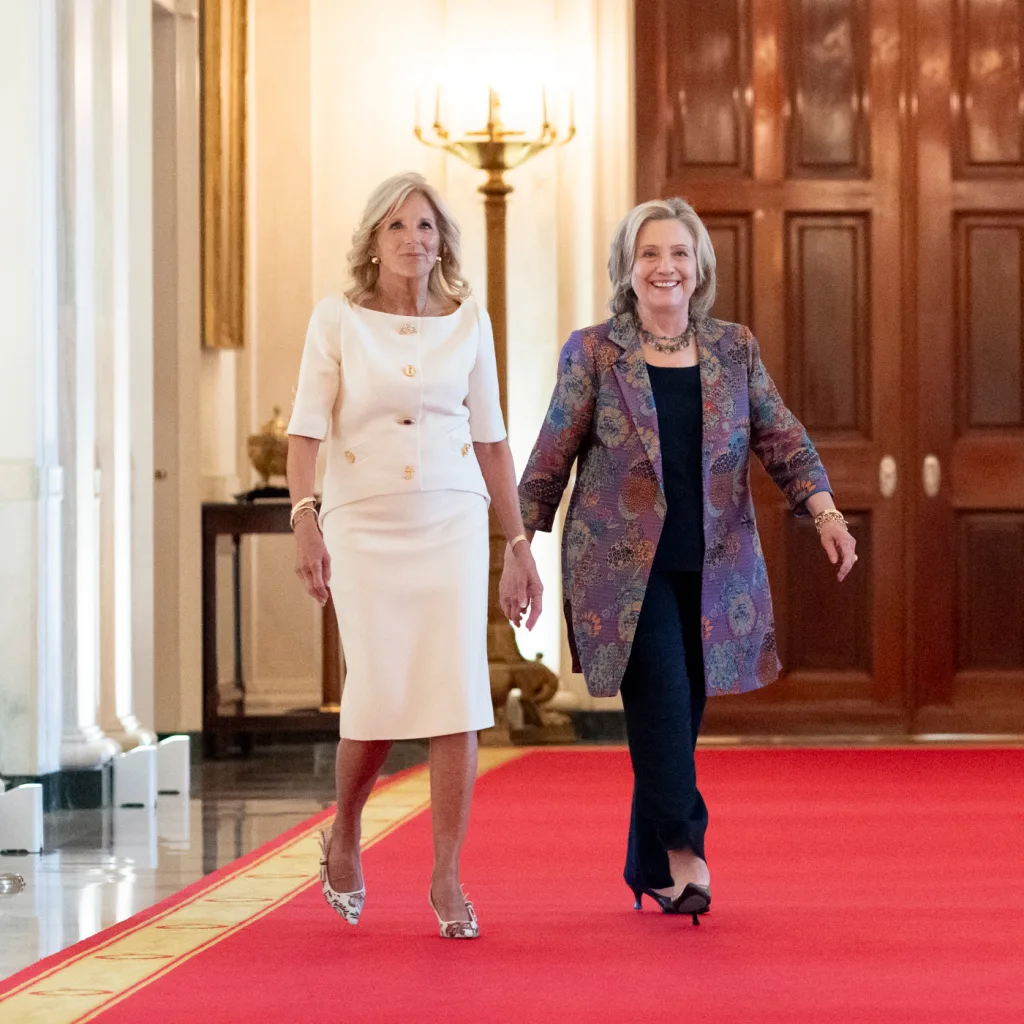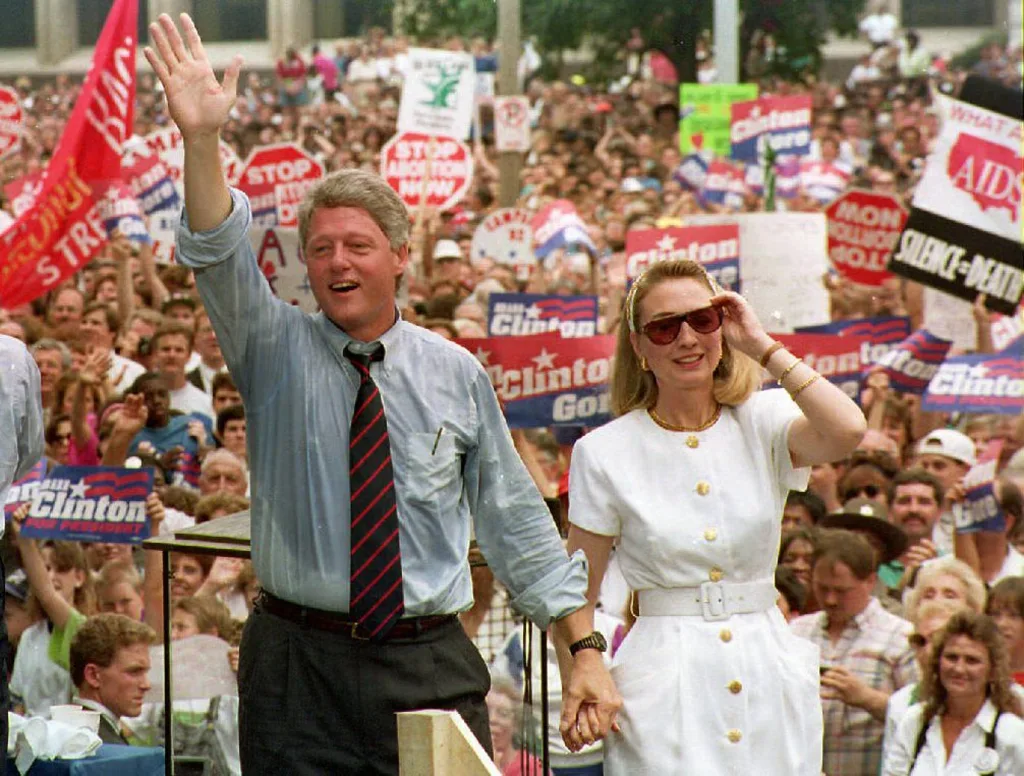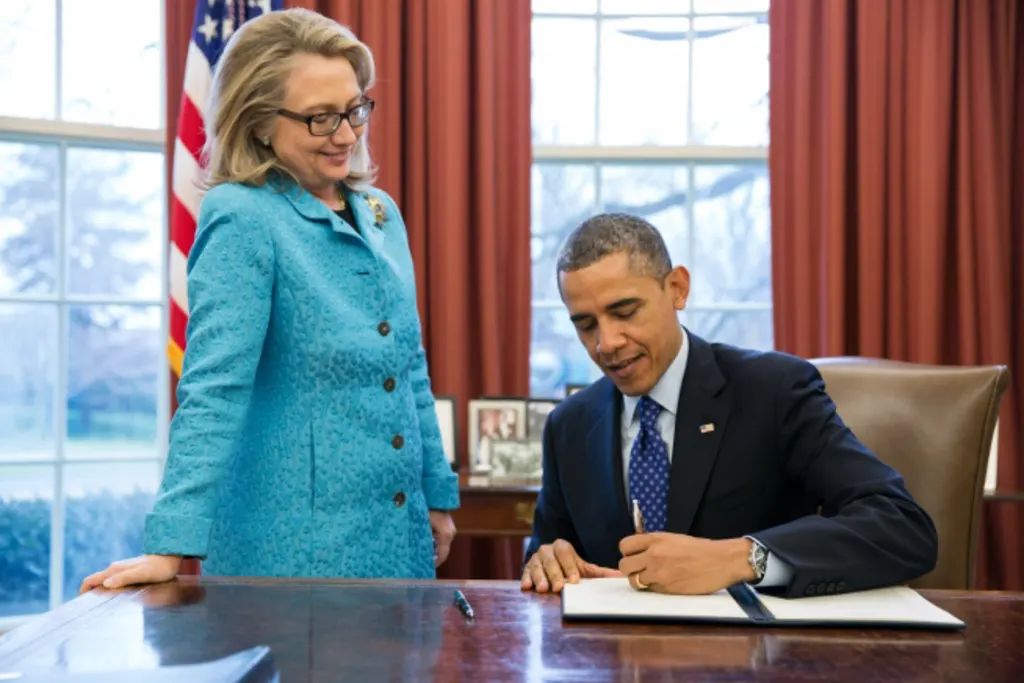Kamala Harris has a uniform. Most days, you’ll find her in a boxy, broad-shouldered suit that mirrors the one worn by her opponent.
Her sartorial choice makes sense. Harris is auditioning for a job that has been held for the past 248 years by 44 white men and one Black man. All of these presidents spent their days in prim, dark suits—the garment Western men have worn for centuries to project power and respectability.
Over the past decade, women vying for the presidency have overwhelmingly chosen to co-opt the suit. But if Harris wins the election and becomes the nation’s first-ever woman president, she’ll be in a position to radically transform our collective imagination of what power can look like. Of course, as a woman of South Asian and Jamaican descent, her face alone will stand apart from all the men who came before her. But she will also have the opportunity to use clothing strategically to emphasize other aspects of her identity. She could, if she wanted, show up in clothes that project even more femininity or even reflect the cultures of her immigrant parents.
While Harris’s fashion decisions might seem insignificant at a time when the future of democracy is at stake, visuals matter mightily in politics. The image of power she projects could help rewrite the norms about who is allowed to ascend into high office in this country. And she could help clear the path for other minorities, making them more electable in years to come.

Hillary and Her Rainbow-Colored Suits
Before Harris, the closest any woman came to the presidency was Hillary Clinton. And Clinton did a great deal to push the boundaries of what political women could wear.
In the ’80s, as women were beginning to enter the workforce in large numbers, many chose to wear the “power suit” with exaggerated shoulder pads. By wearing what had been a traditionally male garment, women were telegraphing that they could take on historically male jobs and serve the role of breadwinner.
And yet, women in the political arena still felt pressure to wear skirts. Throughout the ’80s, female lawmakers who dared to wear pants on the floor were often castigated for not sticking to the unspoken dress code. During the years when Clinton was supporting her husband’s campaign for the White House and then his presidency, she often wore female-coded outfits, like dresses and headbands.

It wasn’t until 1993 that a trio of female senators—Barbara Mikulski, Nancy Kassebaum and Carol Moseley Braun—collectively defied the dress code by wearing trousers on the Senate floor. This prompted Congress to create an official guide that allowed women to wear “coordinated pantsuits” for the first time.
A decade later, in the early 2000s, Clinton began to take on political positions of her own, first as Senator in 2001 and then as Secretary of State in 2009. In these new roles, she was instrumental in shaping the way a woman in power could look. Clinton became famous for wearing boxy pantsuits. At first, she stuck with dark solid colors, like black and blue, allowing her to fit in seamlessly in the rooms full of men wearing similar outfits.
This was a strategic move. In her decades in the public eye, the media constantly dissected her clothing choices, often unkindly. But by wearing the identical outfit as her male counterparts, she shut down much of this gossip, allowing the media to focus on her skills and policy choices.

But then, in the 2010s, Clinton seemed to make the deliberate decision to go beyond the dark suit. She began showing up in suits that had more texture and color. She showed up at the United Nations in 2012 and the Council on Foreign Relations in 2013 wearing tweed suits that took a page from Chanel. In 2013, the day President Barack Obama signed a presidential memo Clinton had helped draft that promoted the empowerment of women and girls globally, she was beside him, wearing a textured suit in a bright shade of teal.
This new sartorial direction seemed designed to suggest a contrast between Clinton and the men in her political orbit who largely wore dark suits. (Indeed, when Obama wore a tan suit to a press conference in 2014, it caused a stir, with Republicans calling him “unpresidential.” He quickly reverted to wearing dark suits.) Clinton was subtly reintroducing femininity and self-expression into her clothing, making the case that women can show up in positions of power as themselves. They didn’t need to cosplay male politicians.
By the time Clinton was running against Trump in 2016, she was famous for her rainbow of pantsuits. In side-by-side photos of the two candidates, Clinton’s clothes were distinctly brighter and more colorful, sometimes veering into pinks and yellows. She often accessorized with bold earrings and scarves. Clinton didn’t want voters to ignore her gender; she invited them to embrace it. The only problem was, she didn’t win.

Can Harris Rewrite the Playbook Again?
This is the sartorial universe that Harris steps into as the presumptive Democratic candidate for President. The current generation of female up-and-comers in the Democratic party—including Gretchen Whitmer and Alexandria Ocasio-Cortez—have all taken a page from Clinton’s fashion playbook of colorful, textured suits. Harris is no exception.
Harris has embraced the pantsuit, but she also opts for more color than men tend to wear. At recent rallies in Atlanta and Philadelphia, she wore a light blue suit. In Dallas, she wore a pink suit to speak with sorority sisters. Even when she wears dark suits, she accessorizes with pearls. The point is not to ignore the fact that she’s a woman. The point is to convince America that a woman can govern.
The question behind this entire campaign whether Americans are ready for a female president. There’s reason to believe things could go differently for Harris than they did for Clinton in 2015. The country has evolved over the last decade. Many young voters and female voters are excited about being part of the movement to elect a woman to the White House.

If Harris does become President, she will be in a position to rewrite the playbook for women in power. Clinton worked hard to find ways to bring her personality into her clothing choices, without going beyond the boundaries of what most Americans would consider presidential. If she wanted, Harris could push those limits even further.
Over the years, we’ve seen glimpses of Harris doing this. She loves Converse sneakers, which she’s worn consistently over the years, paired with skinny trousers and a blazer. In 2019, she had an iconic fashion moment when she showed up at the San Francisco pride parade wearing a bedazzled Levi’s jean jacket with a rainbow on it. She’s known for choosing stylish sunglasses, from Biden-style aviators to fabulous yellow rimmed frames.
Imagine what else she could bring to her look when the election is behind her. When she stops worrying about winning over voters, she could turn her attention to helping Americans rethink what power looks like. Perhaps she could pay homage to the cultures of her parents. Imagine if Harris showed up one day in a suit made of sari fabric, or a scarf made of Caribbean textiles? This would be more than just a form of self-expression. It would be a testament to America’s boundless opportunity that a child of immigrants could ascend into the highest office of the land.